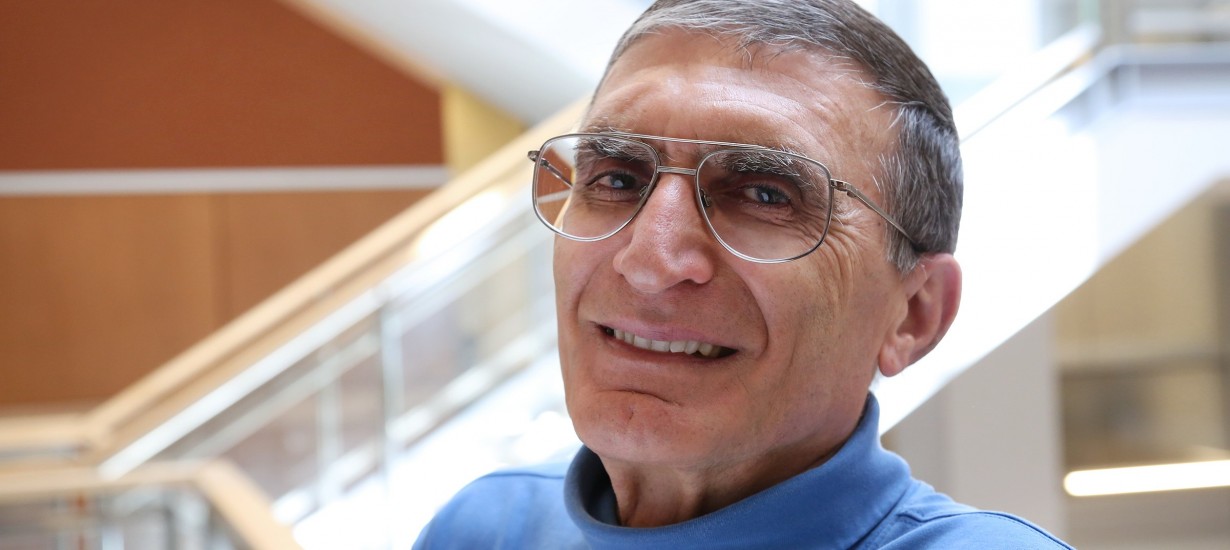Sancar Chosen for Board of Governors' Highest Faculty Award

UNC’s most recent Nobel Prize winner, Aziz Sancar, is one of two professors chosen to receive this year’s O. Max Gardner Award, the UNC System Board of Governors’ highest honor for faculty.
The award recognizes faculty who have “made the greatest contribution to the welfare of the human race.” It carries a $20,000 cash prize and is the only award for which all faculty members from across the system of 16 universities are eligible. It was established by the will of O. Max Gardner (law school class of 1903), who served as N.C.’s governor from 1929 to 1933.
Sancar, the Sarah Graham Kenan Professor of biochemistry and biophysics in UNC’s medical school, shared the 2015 Nobel Prize for chemistry for his groundbreaking work on how DNA repairs itself, becoming UNC’s second Nobel laureate. Oliver Smithies, UNC’s Weatherspoon Eminent Distinguished Professor of pathology and laboratory medicine who has devoted more than 50 years to genetics research, was honored with the Nobel Prize in medicine in 2007.
David A. Shapiro, the Robert Lee Madison Distinguished Professor of communication sciences and disorders at Western Carolina University, is the other 2016 recipient of the O. Max Gardner Award.
The award was presented to Shapiro May 27 during the board’s regular meeting by UNC System President Margaret Spellings and Board of Governors Chair Lou Bissette. Sancar is out of the country and will be recognized at a later meeting of the board.
Born in 1946 in Savur-Mardin, Turkey, Sancar was the seventh of eight children born of illiterate parents who stressed education. Sancar took well to school and to soccer, playing goalkeeper in high school and earning an invitation to try out for Turkey’s under-18 national soccer team, a dream he had held since he was a small child. In the end, he was too short to pursue soccer on the national level and decided instead to focus on his studies. His high marks earned him entrance into the school of his choice in Turkey, and he chose Istanbul Medical School. He graduated in 1969 and practiced medicine near his hometown for two years.
Sancar then earned a NATO fellowship to study at Johns Hopkins, where Stan Rupert had discovered DNA repair in 1958. By the time Sancar met him, Rupert had moved to the University of Texas at Dallas, where he was trying to purify the repair enzyme photolyase but was stymied because the enzyme is not abundant. Sancar joined Rupert as a graduate student in 1974 and worked to increase the amount of the enzyme by cloning the gene that encodes for it. Sancar cloned the gene in 1975, making him the first scientist east of the Rocky Mountains to clone a gene.
For this work, Sancar earned his doctorate in 1977 and moved on as a postdoc to Yale University, where he invented the maxicell method of identifying proteins and figured out the mechanism of another DNA enzyme system called nucleotide excision repair. Sancar cloned the genes responsible for this kind of DNA repair in bacteria and purified the proteins encoded by these genes. These proteins, acting together, cut out a 41-nanometer stretch of the double helix strand to remove damaged DNA.
Sancar returned to his photolyase research in 1982 when he was recruited to Chapel Hill. Once there, he finally purified photolyase and — in collaboration with his wife and biochemistry colleague, Gwen Boles Sancar, and others — showed that the enzyme works as a blue-light-powered machine to repair ultraviolet light-induced DNA damage.
At Carolina, Sancar continued his work on bacterial light-dependent photolyase and nucleotide excision repair and worked out the mechanisms of both systems in exquisite detail in bacteria. By the time he earned his full professorship in 1988, he had begun working on nucleotide excision repair in humans. In 1992, he discovered that human nucleotide excision repair is very different from the bacterial system; the damage is removed by cutting out an 88-nanometer stretch of one strand of the double helix in human cells. In subsequent years, he demonstrated that the human excision repair system requires 15 proteins; E. coli bacteria require only three. He also detailed how these proteins assemble during the repair.
This mechanism repairs the damage to human skin caused by sunlight every day. It also is the mechanism that cancer cells use to defend themselves against the DNA damage caused by the common cancer drug cisplatin. This work culminated in an excision repair map of the entire human genome, which his lab published in 2015.
In addition to this work, Sancar also discovered one of the four genes that control our biological clock. While investigating whether humans have photolyase, he found that humans do have a similar gene that encodes for a similar protein, but the human protein has no repair activity. He named it cryptochrome and showed that it is a vital component of the molecular clock that sets our daily rhythm. Most recently, he discovered how the four circadian clock proteins interact throughout the 24-hour cycle and what this means for treatment paradigms of various diseases, including cancer.
As an educator, Sancar has trained nearly 100 graduate students and postdoctoral fellows as well as hosted many international visiting scientists to his lab. He and his wife founded the Carolina Turk Evi, a house near the University that serves as a host to Turkish scholars and promoting better understanding and increased ties between the U.S. and Turkey.
